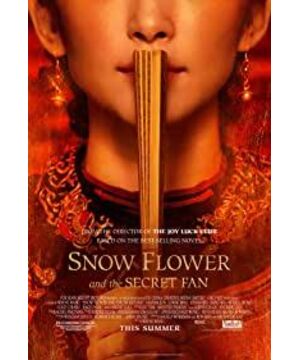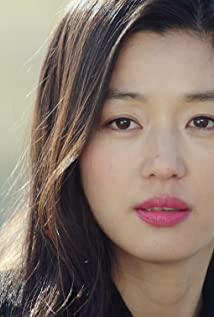There are too many things to say, and the writing is messed up. I haven't set aside the word count to give a good text analysis of this peerless blockbuster. —— Adapted from the English novel of the same name by Chinese American writer Lisa See, Snow Flower and Secret Fan), not a title that can be seen at a glance. The background of the novel is the Yao village in Hunan before and after the Taiping Heavenly Kingdom. "Snowflake" is the "Old Tong" of the narrator Lily - born in the same year, same month and same day, one-to-one, loyal to each other than a couple's sworn sisters throughout their lives, "Secret Fan" is a token of "Lao Tong"'s friendship. It uses the secret text "Nu Shu" exclusive to local women to record and exchange the experience of major moments in life: the first sentence on this folding fan is that the seven-year-old Xuehua asked Lily if she would like to marry her, and the last sentence is After Xuehua died of illness, Lily, who was full of regrets, wrote that Xuehua had "flyed to the sky" and hoped that "we can fly together" in a hundred years. Interestingly, snowflakes are not flowers, so why not use the idiomatic translation of the word? It can only be said that naming Chinese women after flowers for a long time is a kind of Western thinking inertia. Although the original author is of Chinese descent, whether it is a novel or a movie, the way of viewing China is marked with Orientalism. The folklore show film of "flower" and "fan" adds the dimension of time and space to modern Shanghai. Sophia, a descendant of the Lily family who grew up in South Korea, and Nina, a local girl from Shanghai, performed a sisterhood similar to Lily Snowflake: At that time, Sophia, who was from a well-off family, was like Xuehua, who was in the middle of the family and lived in desperation. The change of the white cloud and the dog in her personal encounter almost destroyed the female friendship that had surpassed all other social relations. "Snowflake and the Secret Fan" became a family legend written by Sophia. After she was in a coma in a car accident, Nina read Sophia's manuscript by her hospital bed, a story from a century and a half ago interspersed with Nina's memories. It can also be classified as a feminist niche literary film. In terms of kinship, "Snowflake and the Secret Fan" and "Guanyin Mountain" are far inferior to "Red Sorghum", "The Last Emperor", "The Big Red Lantern" and "The Big Red Lantern" Folklore blockbusters such as Farewell My Concubine are very close. Folklore in folklore movies is not a neutral concept. The reason why this kind of display attracts attention is the difference between the East and the West, the old world and the new world; the audience is eager to find in an ancient country. Westerners of the wonders of the East. They think of themselves as strong, and what they want to see is a poor, ignorant, and exotic "other". The fifth generation of directors once targeted the jury of the three major European art film awards, and spared no effort to imagine China in this way. Although Lisa Kwong claims to be of Chinese descent, her cultural identity as an author can only be a Westerner with goodwill towards Chinese traditions. The difference between "Snowflake and the Secret Fan" and the fifth-generation work "Self-colonization" is obvious. The hodgepodge of folk customs of the fifth generation is also to avoid the big cities that Westerners are tired of, and to go deep into the backcountry to find outdated things, but these The tradition sometimes bursts out with abundant and strong vitality in the grand narrative, placing the author's gloomy vision of national rejuvenation. On the other hand, in the contemporary "The Last Emperor", the narrative is not too grand, but the eyes of the puppet emperor Pu Yi are not criticism, but sympathy. It seems that Puyi has always been an involuntary child. His traitorous behavior is due to his inability to help himself as a "hostage of history". This is a position that only "outsiders" can live in comfortably. "Snowflake and Secret Fan" also uses such sympathetic brushstrokes to depict those Chinese women who were imprisoned at home more than a century ago. The folk symbols in the book that have more presence than "Nvshu" can also be said to be the real protagonist of the book, "Three-inch Golden Lotus". In terms of plot setting, a pair of perfect little feet made Baicheng the eldest daughter-in-law of a famous family, and the gap in status made her drift away from Xuehua. They are the "mothers" who have been tortured, still gentle and tough, and maintain a strong fertility. In the dreamland novel of desire and terror, when Lily binds her feet, her mother's words reverberate like a proverb, which seems to be the main theme of the whole book. While pulling Lily's "broken toe bone", she said, "Only after suffering can we have true beauty, and only after suffering can we have true peace." The author faintly advocates that traditional women experience the pain of being closed and submissive. The spiritual power nurtured in life can still be absorbed by people today. It's reminiscent of Pearl Buck's The Good Earth. Earth) and its film of the same name. The heroine, Alan, is a house girl married to a poor peasant household. Whether it is famine or a well-off life, assisting her husband in troubled times, or being neglected by her husband after making a fortune, she only seeks dedication and abides by women's virtues, and is the embodiment of an ideal woman. Her husband, Wang Lung, said, "She is the earth!" "The earth" won a lot of Nobel and Oscar awards, and when it was released in 1937, it made a staggering $25 million at the box office. Its success in mainstream Western society, especially in the United States, may be due to the history of the Alan couple's homesteading, which secretly praised the American Puritan ethics. Pearl Buck and Lisa Kwong came to China to do some agronomic and anthropological investigations. When they went back, they deduced several novels about Chinese rural areas. Separation and misreading are inevitable - who told Lisa Kwong that her husband died and that her real wife was going to be sold? However, it has been the most friendly for a hundred years to explore the cultural value of traditional China through observation and sympathy. Someone once said, "In the image of China in Western culture, China is not a real country, but a dreamland that hides the desires and terrors of Westerners", an "invisible city" and a container for them to project their imaginary enemies. For more than a century, the "Mother Earth" has not been seen much in the images of Chinese women in Western images, and the "Lotus" and "Dragon Girl" are the mainstream. Another name for "Lotus Flower" is "China Doll". "Lotus" is a variant of the dramatic image of Madame Butterfly in the film field. Since the era of silent films, the Chinese woman named "Lotus" in the film has been as handy as "Xiao Ming" and "Xiao Hong" in elementary school students' essays. The key words of "Lotus" are femininity, vulnerability and sacrifice. They admire Western civilization, help and fall in love with white people in China, and white people will eventually abandon them and let them wither in grief. One of the most famous lotus flowers is Toll of the Sea, starring Chinese actress Anna May Wong in 1922. She died by throwing herself into the sea. Perhaps it is this colorful film that has made a name for itself in the history of film, so that the academic circles name such stylized characters so. The "Dragon Girl" is the opposite of the "Lotus", they are usually the assistants of "Fu Manchu" (stylized Chinese male character), a deadly temptation, mysterious, deceitful, untrustworthy, carrying out evil attacks on Western civilized society plan. The role of Fu Manchu's daughter in Daughter of the Dragon in 1931 inspired cartoonist Milton Caniff. Caniff, whose comic series Terry and the Pirates synthesizes the new term "Dragon Girl". Whether it is "Lotus" or "Dragon Girl", there is also a common name, "Geisha", they seem to never have family control, and white people can get them at will. It is quite ironic that "Snowflake and the Secret Fan", which expresses the life of China's rural areas with no door and no second door, superimposes the imagery of "flower" and "fan", which will undoubtedly remind Western audiences of "Mrs. Butterfly" and "Mrs. Butterfly". Memoirs of a Geisha. Don't such Chinese women come from an imagined land of nowhere? East is West? Perhaps, some people will refute that the fear of the "yellow peril" does have a realistic basis, which is the Boxer war against the Eight-Power Allied Forces. This is the painful "first close contact" between the western world and China in modern times. If you don't see Cixi's biography, it is named after "Dragon Girl". However, Fu Manchu and his daughter remained active until the seventies. Yu Jiaolong in Ang Lee's "Crouching Tiger, Hidden Dragon" is still a "Dragon Girl", and she still cannot escape death. The Boxer Rebellion was a hundred years ago. Why did Western filmmakers tell the story on the screen how "Fu Manchu" and "Dragon Girl" intended to subvert Western civilization for decades? The "yellow peril" theory supports racism in the second half of the 19th century. Racists draw inspiration from Darwin's theory of evolution, use race to divide people, and believe that race is divided into superior and inferior, the survival of the fittest, and the survival of the fittest. It can be said that since modern times, maintaining the purity of white blood has been the focus of Eastern themes. The 1918 stage play "East is the West" (East is the West) West) is typical. The son of the American master in China fell in love with the Chinese girl Mingwa, and finally everyone found out that Mingwa was the daughter of a Spanish missionary. "The East can never be the West". If she didn't reveal her white blood, Mingwa could not live to the end of the play according to the rules. Anna May Wong has a very popular saying, she said with bitterness: "(On the screen) I have died a thousand times." In her day, it was by no means an artistic hyperbole. The same is true for male characters. Suspected bloodlines often constitute the main line of conflict in the plot. Those who can exclude Chinese blood can have a happy ending. It is proved that mixed blood is a dead end. The novel "The World of Susie Huang" published in 1957 and its film of the same name are milestones in the evolution of "Lotus". For the first time, a "geisha" not only did not die on the screen, but also got the love of a white man. Today's audience saw Jun Ji-hyun, who had an emotional entanglement with Australian actor Hugh Jackman in "Snowflake and the Secret Fan", opened his eyes at the end of the film. He didn't expect that being a yellow-skinned woman would be better than dying in a B-movie. Thousands of seniors, what a blessing this is. East and West, in the colonial discourse of Orientalism, are synonymous with backwardness and progress. This also explains why Chinese films have lost the ability to represent cities over the past two decades. Metropolis is also a feast for the eyes, which is commonplace for Westerners. If they don't want to watch it, we won't shoot it. If things go on like this, we won't be able to capture the soul of Chinese cities. In movies shot by Westerners, Chinese cities are even more distorted. The Beijing in "Beijing Waiting" and "Kung Fu Dream" has made many people fall short of their glasses: is this the city we live in every day? In the ancient part of "Snowflake and the Secret Fan", the original novel's anthropological observation report is a flat-panel narrative. It only grabs only scales and claws, which already makes people feel isolated. , the city where the protagonists are active is more illusory than the dream builders in "Inception". The long-term demonized narrative once blocked the way for the West to understand the East. Getting through this road is far more difficult than blocking it. In the third part of "The Mummy", Qin Shihuang and his resurrected legion were like Fu Manchu back in the arena, and their heads were swept away by the machine guns of Western adventurers. Fortunately, the "Dragon Girl" Liang Shiluo survived, and he kissed the protagonist's son. ——Su Wan, July 13, 2011, "Art Newspaper" Explains why Chinese films have lost their ability to represent cities over the past two decades. Metropolis is also a feast for the eyes, which is commonplace for Westerners. If they don't want to watch it, we won't shoot it. If things go on like this, we won't be able to capture the soul of Chinese cities. In movies shot by Westerners, Chinese cities are even more distorted. The Beijing in "Beijing Waiting" and "Kung Fu Dream" has made many people fall short of their glasses: is this the city we live in every day? In the ancient part of "Snowflake and the Secret Fan", the original novel's anthropological observation report is a flat-panel narrative. It only grabs only scales and claws, which already makes people feel isolated. , the city where the protagonists are active is more illusory than the dream builders in "Inception". The long-term demonized narrative once blocked the way for the West to understand the East. Getting through this road is far more difficult than blocking it. In the third part of "The Mummy", Qin Shihuang and his resurrected legion were like Fu Manchu back in the arena, and their heads were swept away by the machine guns of Western adventurers. Fortunately, the "Dragon Girl" Liang Shiluo survived, and he kissed the protagonist's son. ——Su Wan, July 13, 2011, "Art Newspaper" Explains why Chinese films have lost their ability to represent cities over the past two decades. Metropolis is also a feast for the eyes, which is commonplace for Westerners. If they don't want to watch it, we won't shoot it. If things go on like this, we won't be able to capture the soul of Chinese cities. In movies shot by Westerners, Chinese cities are even more distorted. The Beijing in "Beijing Waiting" and "Kung Fu Dream" has made many people fall short of their glasses: is this the city we live in every day? In the ancient part of "Snowflake and the Secret Fan", the original novel's anthropological observation report is a flat-panel narrative. It only grabs only scales and claws, which already makes people feel isolated. , the city where the protagonists are active is more illusory than the dream builders in "Inception". The long-term demonized narrative once blocked the way for the West to understand the East. Getting through this road is far more difficult than blocking it. In the third part of "The Mummy", Qin Shihuang and his resurrected legion were like Fu Manchu back in the arena, and their heads were swept away by the machine guns of Western adventurers. Fortunately, the "Dragon Girl" Liang Shiluo survived, and he kissed the protagonist's son. ——Su Wan, July 13, 2011, "Art Newspaper"
View more about Snow Flower and the Secret Fan reviews











